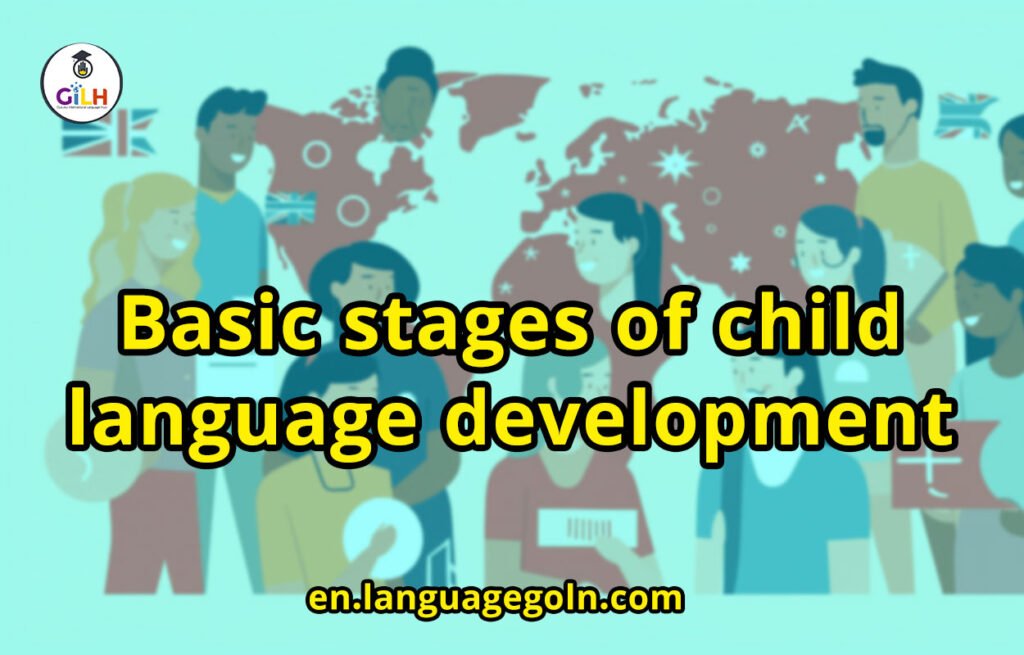Today our topic of discussion is – Basic stages of child language development
Basic stages of child language development
Based on the above mentioned stages and depending on few more studies; like, Reich (1976), Clark & Clark (1980), Stoel-Gammon (1989), Tager-Flusberg (1997) the most widely taken stages of child language acquisition are as follow-
Vocal play
(a) Crying: Children’s very first vocal response is called ‘Birth cry’. It is produced to convey basic physiological needs (hunger, thirst) or to express fear, pain or discomfort.
(b) Cooing: As early as six weeks.
Children at this stage make cooing sounds (like /aaa/, /uuu/ etc.) by manipulating their tongue, mouth breathing. Usually the vowel sounds occur before the consonantal sounds. Cooing behaviour specifies the infant’s ability to experiment with making sounds.
(c) Babbling: Infant’s sound production becomes more varied and complex when they start to babble at the age of 4-6 months. Usually babblings are produced by repeating vowels and consonant sounds such as /baba/, /kuku/ (Clark & Clark, 1980). Babble sounds are used randomly, and unlike words, do not refer to a specific person, object or event.
Moreover, it can be used both before and after first word use. Sachs (1993) referred to another type of babbles which is called ‘echolalic babbling, reflecting the intonation and rhythm of adult speech in the child’s environment. This complex type of babbling appears in 8-10 months.
These three early stages of language acquisition are described together as ‘vocal play’.
One word stage
Child’s first words are typically those used by their primary caregivers. About one year of age, children begin to make words like units. These words are often used in a specific situation or routine and commonly found in a child’s home environment.
The first words are related to the intellectual and social development of the child. Idiomorphs are another inclusion in the ‘one word stage’ (Reich, 1976). These words might be invented; for example, a child might invent a special word for his toy or personal
things. Such inventions are considered to ‘idiomorphs’, they are words that are stable and used to refer to a particular object on a consistent basis.
The one word stage is significant to children’s development as they use the constant language unit to communicate meaning. It is remarkable that parents and family members often adopt the child’s invented words or pronunciation as a means of encouraging the child to talk. The single word stage is also referred to as the ‘holophrastic stage’ (specifically when the child completes a whole meaning only through the use of a single word).
Two word stage
After a few months of producing one word utterances, the child begins to use two-word utterances, and will continue until 2.5 years of age. Slowly single words are added to the child’s vocabulary, as they usually talk about the same thing. Many of these are almost identical to single word utterances.
It is like ‘noun-noun’ or ‘noun- verb’ form (mom shoe). This stage is also called the “word spurt’ or ‘Naming Explosion’ period. Children seem to show better understandings of syntax and semantics. And it looks like LAD is active here. The word ordering used here is the same as adults (mostly).
Telegraphic stage
This is the final stage of language production before the child can speak fluently. As the toddlers develop their vocabulary of speech, they begin to string the words together. This is referred to as telegraphic speech because they only use content words to communicate without articles, conjunctions, prepositions or word endings (Tager- Flusberg, 1997). For example ‘daddy water’, ‘baby doll’ etc.
This telegraphic stage is significant because children are arranging words to communicate more complex messages. Children show a particular style of word learning and use a lot of naming words like “ball, doll, boy'( might be word lover’) or use more personal words and social words like ‘hello’,
no’, ‘please’, ‘thank you’ (being ‘word leaver’). The telegraphic stage comprises a high proportion of frozen phrases like ‘all gone’, ‘come on’ and ‘sit down’ etc.
Beginning oral fluency
. Children generally become moderately fluent in the language used at home by the age of 3 or 4 years. They use the oral language to communicate their thoughts, answering questions or to ask questions. During the remainder of the pre- school period their oral language becomes more complex in grammar and vocabulary and more varied in the ways in which they use language to communicate with others, both in their family and in their community.
British linguist M.A.K. Halliday (1974) proposed a systemic theory of language that unites earliest meaningful utterances with those needed to enact as adults. Halliday thinks that humans develop language because it is the primary resource for meaning and communication. According to Halliday, early language acquisition stages are-
(a) Function: What children endeavor to do with their language (e.g. making requests. asking questions or give statements).
(b) Meaning: The states, events and relationships that children speak about. Meaning here refers to the meaning of the performance shown. Children may have competence which they have no opportunity to demonstrate.
(c) Structure: The way in which the language is composed, its grammar.
Halliday considers Phase I of language development (ie. The protolanguage stage) evolutionary, created through interactions with mother tongue native speakers (i.e., caregivers, siblings, etc.) and consisting of basic pairs of content/expression (not yet words,
let alone higher order systems) and performing concrete functions in the world. The main functions he believes early language acquisition serves are-
- naming things
- describing things real and imaginary
- influencing the behaviour of others
- expressing feelings
- thinking and problem solving
- asking questions
- communicating – taking part in language interactions
Subsequently this phase-1 stage becomes the logical and necessary precursor to the lexico-grammatical phase- II. It bridges the protolanguage to the development of phase-III, mother tongue.
See more

